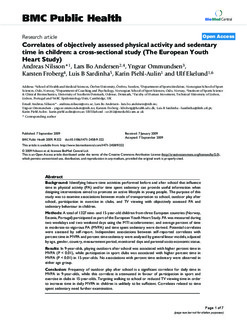| dc.contributor.author | Nilsson, Andreas | |
| dc.contributor.author | Andersen, Lars Bo | |
| dc.contributor.author | Ommundsen, Yngvar | |
| dc.contributor.author | Froberg, Karsten | |
| dc.contributor.author | Sardinha, Luis B. | |
| dc.contributor.author | Piehl-Aulin, Karin | |
| dc.contributor.author | Ekelund, Ulf | |
| dc.date.accessioned | 2009-10-20T12:41:25Z | |
| dc.date.issued | 2009-09-07 | |
| dc.identifier | Seksjon for idrettsmedisinske fag / Department of Sports Medicine | |
| dc.identifier.citation | BMC Public Health. 2009, 9(322) | en |
| dc.identifier.issn | 1471-2458 | |
| dc.identifier.uri | http://hdl.handle.net/11250/170429 | |
| dc.description | © 2009 Nilsson al; licensee BioMed Central Ltd. This is an Open Access article distributed under the terms of the Creative Commons Attribution License (http://creativecommons.org/licenses/by/2.0), which permits unrestricted use, distribution, and reproduction in any medium, provided the original work is properly cited. | en |
| dc.description.abstract | BACKGROUND: Identifying leisure time activities performed before and after school that influence time in physical activity (PA) and/or time spent sedentary can provide useful information when designing interventions aimed to promote an active lifestyle in young people. The purpose of this study was to examine associations between mode of transportation to school, outdoor play after school, participation in exercise in clubs, and TV viewing with objectively assessed PA and sedentary behaviour in children. METHODS: A total of 1327 nine- and 15-year-old children from three European countries (Norway, Estonia, Portugal) participated as part of the European Youth Heart Study. PA was measured during two weekdays and two weekend days using the MTI accelerometer, and average percent of time in moderate-to-vigorous PA (MVPA) and time spent sedentary were derived. Potential correlates were assessed by self-report. Independent associations between self-reported correlates with percent time in MVPA and percent time sedentary were analysed by general linear models, adjusted by age, gender, country, measurement period, monitored days and parental socio-economic status. RESULTS: In 9-year-olds, playing outdoors after school was associated with higher percent time in MVPA (P < 0.01), while participation in sport clubs was associated with higher percent time in MVPA (P < 0.01) in 15-year-olds. No associations with percent time sedentary were observed in either age group. CONCLUSION: Frequency of outdoor play after school is a significant correlate for daily time in MVPA in 9-year-olds, while this correlate is attenuated in favour of participation in sport and exercise in clubs in 15-year-olds. Targeting walking to school or reduced TV viewing time in order to increase time in daily MVPA in children is unlikely to be sufficient. Correlates related to time spent sedentary need further examination. | en |
| dc.format.extent | 218505 bytes | |
| dc.format.mimetype | application/pdf | |
| dc.language.iso | eng | en |
| dc.publisher | BioMed Central | en |
| dc.subject | adolescent | |
| dc.subject | child | |
| dc.subject | cross-sectional studies | |
| dc.subject | Europe | |
| dc.subject | exercise | |
| dc.subject | female | |
| dc.subject | humans | |
| dc.subject | life style | |
| dc.subject | male | |
| dc.title | Correlates of objectively assessed physical activity and sedentary time in children: a cross-sectional study (The European Youth Heart Study) | en |
| dc.type | Peer reviewed | en |
| dc.type | Journal article | en |
| dc.subject.nsi | VDP::Medical disciplines: 700::Health sciences: 800 | en |
| dc.source.volume | 9 | en |
| dc.source.journal | BMC Public Health | en |
| dc.source.issue | 322 | en |
